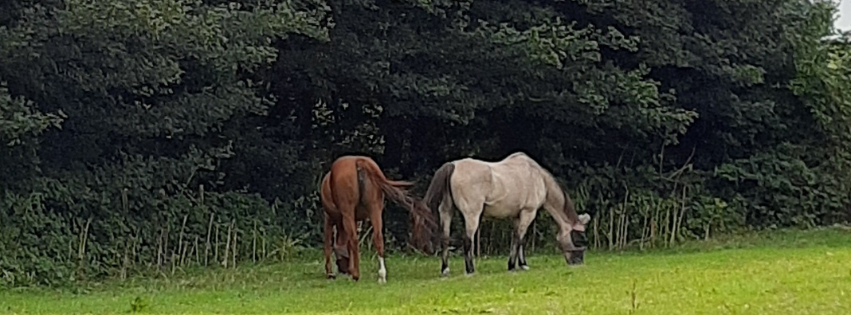Pain & Inflammation in Horses
Pain is probably the most disruptive symptom in life, where injuries and illness can outlive their original causes, worsening over time and taking on a debilitating life of their own.
Pain and inflammation are the single biggest factors that prevent our horse from staying fit and healthy. And pain can be complicated, as we can have it for a lot of different reasons. There’s pain due to muscle spasm and tension. There’s pain because of irritation and inflammation. There’s pain because of swelling. There’s pain because of a nerve being stimulated. All very different types of pain.
We know only too well that our beloved horses are prone to needing support to stay comfortable, especially as they get older. Certainly many racehorses have to be retired early through devastating tendon and ligament injury, with their joints degenerating long before their time. And while getting older is inevitable, the associated aging-effects are not - aches and pains are abnormal aging and it doesn't have to be like this for any of us, whether human or horse.
Pain is usually described as acute or chronic, and this is more based on the duration of the pain, rather than its intensity. Acute pain actually has a function; it occurs as an immediate protective response to prevent tissue damage due to a harmful event. The duration of acute pain is relatively short, usually measured in hours to days, and is typically the type of pain associated with surgery or trauma, i.e. laminitis.
Chronic pain, however, serves no function, protective or otherwise, and is of no benefit whatsoever, its duration being prolonged, usually measured in weeks to months or even years, and often permanent. As per its name, it's typically the type of pain associated with chronic conditions, i.e. arthritis.
Alleviating acute pain is very different from chronic pain, with chronic pain management very challenging for the carer. Research shows that chronic pain can also be destructive to the body - harmful hormones such as cortisol, the stress hormone, are released, which adversely affects the immune system and kidney function.
It’s also well known that conventional drugs such as bute can damage the liver, especially if the injury or illness is such that the horse has to spend months, if not years, on some form of synthetic pharma drug.
Worryingly, one method of dealing with chronic discomfort in our horses is to sever the sensory nerves, the thinking being that severed nerves can't transmit pain because they cause complete numbness. Emphasis on the numbness - I simply don't get this because certainly in humans, we all know what happens when a leg or foot becomes numb. Try walking - It's simply not possible! We fall over, literally, because we can't feel our foot, so how can this be an appropriate 'do no harm' method for our horses?
Worse, while these severed nerves usually stay dead, sometimes they grow back irregularly, or begin firing spontaneously, producing stabbing, shooting, electrical sensations.
Associated nerves also appear to recruit others, leading to the entire central nervous system becoming involved. Research has shown that with prolonged injury, progressively deeper levels of related cells are activated in the spinal cord. The science shows that appropriate management can help suppress this abnormal nervous system sensitivity, and that it's far easier to avoid these abnormal channels establishing in the first place, than have to treat them once in occuring. (University of California, San Francisco)
There's no question - long-term prescription of pharma drugs for chronic pain not only has questionable benefits but also significant risks, from physiological dependence and withdrawal, to depression and hormonal dysregulation to cardiovascular disruption.
Doing it naturally
Pain and discomfort should obviously be alleviated immediately - coping with acute levels is counter-productive as it can become deep-rooted and chronic.
Due to the potential medical complexity of chronic pain, a comprehensive strategy that includes an effective non-pharmacological approach can be vital. Amongst a range of complimentary therapies, research also shows that both nutritional modifications and supporting mitochondrial health are examples of promising therapeutic interventions for chronic pain.
Supporting mitochondrial function
This showing to be a promising strategy to alleviate or prevent chronic pain. Nerve cells' mitochondria have a variety of essential functions, with studies showing they play critical roles in neuropathic and inflammatory pain. Although this area of pain research is relatively new, mitochondrial dysfunction has been confirmed in both human and animal chronic pain patients. Flatters SJ. The contribution of mitochondria to sensory processing and pain & Sui BD, Xu TQ, Liu JW, et al. Understanding the role of mitochondria in the pathogenesis of chronic pain
Diet
In human health, there's a Functional Medicine stat that shows for every 10% increase of ultra-processed food in our diet there's a 14% increased risk for all-cause mortality, with junk food also linked to psychological distress. As I repeatedly say across this website, 'everything starts with the gut', and as a first step in supporting mitochondrial stability, and with increasing evidence that diet can contribute to systemic inflammation, focusing on supporting the microbiome and healthy mitochondria with species-appropriate feed alongside therapeutic foods (herbs), will help support mitochondrial energy production, energy metabolism, and hence overall health.
There's increasing evidence that diet can contribute to systemic inflammation, with pain perception commonly related to inflammatory stimulus and mediators. Staying with human health, the most explored dietary triggers for chronic pain include cow’s milk antigens (alpha-lactalbumin, beta-lactoglobulin, casein) and eggs, but also wheat/wheat gluten and soy proteins, both of which feature heavily in many processed feed brands, so if you've got anything wheat/soya listed as an ingredient, it could be that dumping the junk feed will make a positive difference to pain levels.
Therapeutic exercise
This also supports the mitochondria, promoting increased mitochondrial content and respiratory capacity of each mitochondria. Memme JM, Erlich AT, Phukan G, Hood DA. Exercise and mitochondrial health
For chronic musculoskeletal pain, dietary markers have been identified for inflammatory arthritis. A 2019 study suggests that vitamin D deficiency may be associated with lower back pain, so rug-free turnout in sun, sun, and more sun. Dzik KP, Skrobot W, Kaczor KB, et al
Beyond diet - natural therapies
Meanwhile, if we're thinking about extending comfortable longevity we have to think beyond diet.
- Massage - the manipulation of superficial and deeper layers of muscle and connective tissue. Theories of massage mechanisms for treating acute pain include blocking nociception (a signal arriving at the central nervous system due to stimulation of specialised sensory receptors in the peripheral nervous system called nociceptors), stimulating release of endorphins and serotonin, preventing fibrosis or scar tissue, and increasing lymphatic flow.
- Physical Therapy - focuses on exercises for stretching, strengthening, and endurance, to help the return of normal function, and preventing the loss of mobility and flexibility before it occurs. Often accompanied by massage or other types of therapy. There are both acute and chronic pain management applications for physical therapy.
- Hydrotherapy - utilises water as a vehicle to apply heat or cold, resulting in changes in blood flow to the area. A combination of heat and cold has become popular and is believed to improve circulation and lymphatic drainage. It may also decrease injury in acute stages by stimulating blood flow and reducing swelling.
- Therapeutic Ultrasound - utilises high-frequency sound waves to stimulate tissue beneath the skin surface, and is believed to provide three primary benefits: increased blood flow which may speed recovery; decreased swelling and edema which decrease pain; gentle massage of tissues.
- Laser Therapy - its effectiveness is dependent on dose, wavelength, timing, pulsing, duration, and location (joint vs. nerve). Laser therapy is thought to decrease the mediators of inflammation which will decrease pain, and increase cell proliferation and wound healing. I'm a huge fan - after a nasty ankle double fracture I bought myself a hand-held infrared laser off Amazon and applied it regularly; the relief, as well as an immediate increase in flexibility, was tangible (alongside applying our JSTGel as well). I still use it regularly when the joint gets stiff, and a friend even borrowed it for her dog when her horse kicked - and broke - her dog's hip.
- Acupuncture - based on the belief that disease results if the flow of qi energy through the body is disrupted, and that the stimulation of acupoints restores balance. Acupuncture recruits the body’s own pain reduction system, and release of endorphins, serotonin, norepinephrine, and gamma-amino butyric acid (GABA). There are both acute and chronic pain management applications for acupuncture.
- Chiropractic - the relationship between structure and function. A form of manual therapy using controlled forces that are applied to specific articulations or anatomic regions, inducing a therapeutic response via induced changes in joint structures, muscle function, and neurologic reflexes. Equine chiropractic is a complementary modality that may be used for select musculoskeletal disorders in horses. Often supplemented with massage, physiotherapy modalities, and stretching or strengthening exercises.
The natural world has been very generous with superior support for our horses. Working in synergy, specific herbs enhance each others' active components for a superior, safe and effective solution, for extending longevity into those senior years as well as for both short-term acute and long-term chronic states.
* Our Pain/Inflammation product range.










